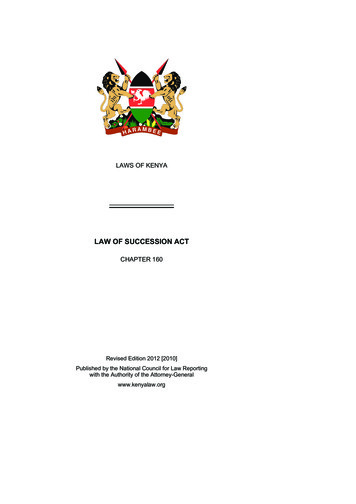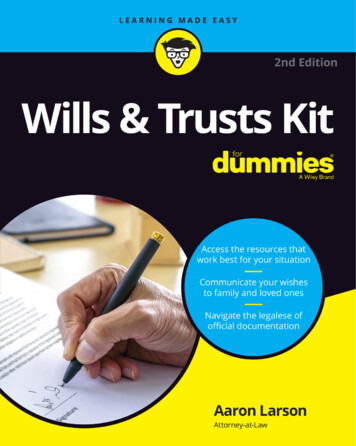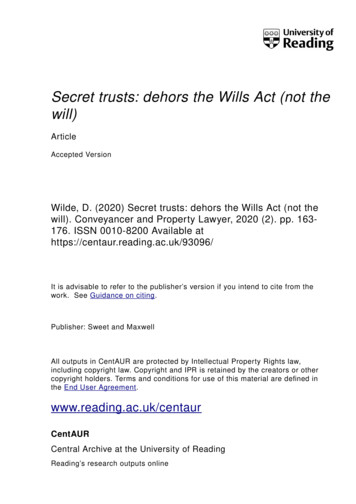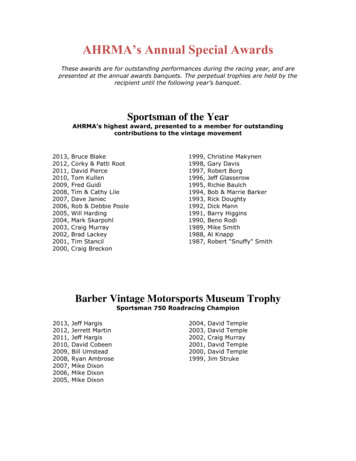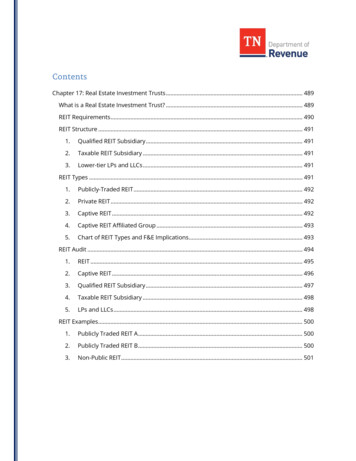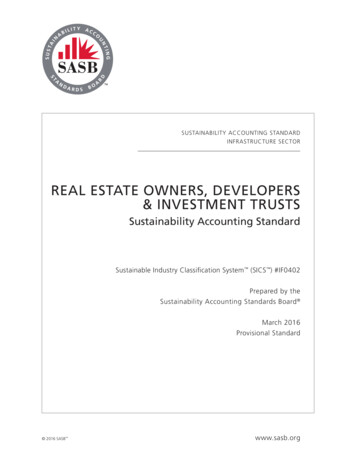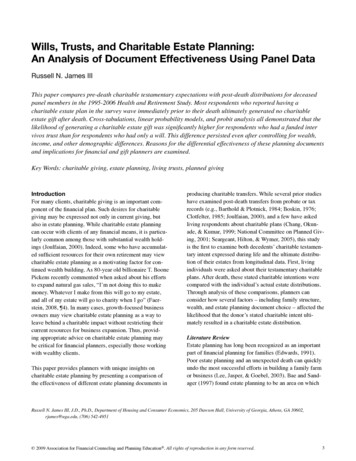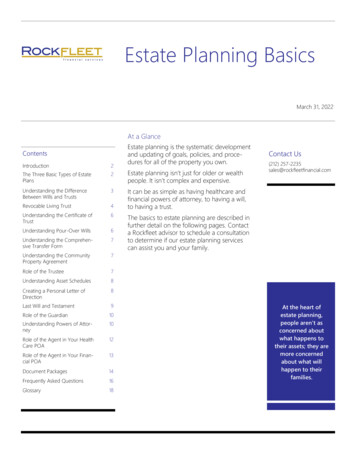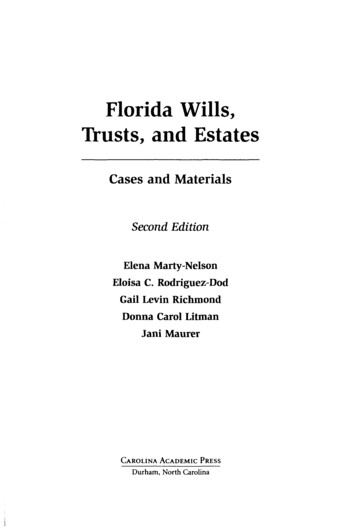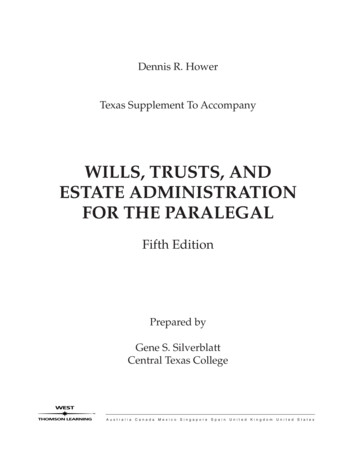
Transcription
Dennis R. HowerTexas Supplement To AccompanyWILLS, TRUSTS, ANDESTATE ADMINISTRATIONFOR THE PARALEGALFifth EditionPrepared byGene S. SilverblattCentral Texas CollegeA u s t r a l i aC a n a d aM e x i c oS i n g a p o r eS p a i nU n i t e dK i n g d o mU n i t e dS t a t e s
To my students and those of other Legal Assistant Programs:In addition to my twenty years working with wills, trusts, and probate, I have been teaching paralegal students for eighteen years at last count. Of all the courses I have taught, none has allowed me the hands-on approach that this area has. From the simulated interview of a probate client, to the drafting of probate documents asnew facts were presented to the students each week, to the execution of a new will for the hypothetical client, mystudents receive a close look at what paralegals really do. I am therefore honored to offer some assistance to teachers and students in the area of wills, trusts, and probate.Although I could have hit on the corresponding Texas citation for each Uniform Probate Code Section givenin the main text book, I felt it would be more appropriate to hone in on those areas that the teacher and paralegalstudent will need to best prepare them for practicing in this area, most notably in the area of probate.To simplify things, I have abbreviated the Texas Probate Code as TPC and the Uniform Probate Code, naturally, as UPC. Likewise, Family Code is abbreviated as Fam. C., Property Code as Prop. C., and the Texas TaxCode as Tax. C. The term letters includes letters testamentary and letters of administration unless otherwise specified.Finally, I have included some forms as examples of those I use in my private practice. The instructor maywish to use some of these for drafting assignments. They are clearly no substitute for a good Texas form book, andI have not spent much time cleaning them up. Nevertheless, I think they help the paralegal student relate to thesubstantive material.Best of luck in your course of studies!
CONTENTS1The Purpose and Need for a Will 42The Concept of Property Related to Wills, Trusts, and Estate Administration3The Participants and the Proper Court4The Law of Succession: Death Testate or Intestate5Wills: Validity Requirements, Modification, Revocation, and Contests 156Preparation to Draft a Will: Checklists and the Conference with the Client7Final Draft and Execution of a Valid Will 208Introduction to Trusts9Classification of Trusts, the Living Trust, and Other Special Trusts 355793310Estate Planning and Long-Term Care 3611Personal Representatives: Types, Pre-Probate Duties, and Appointment12Probate and Estate Administration13Informal Probate Administration14Tax Considerations in the Administration of Estates 6615Ethical Principles Relevant to Practicing Legal Assistants 67374459In this supplement, a page reference follows each head—(Hower 000). This page referencecorrelates with Dennis Hower’s textbook, Wills, Trusts, and Estate Administration for theParalegal, Fifth Edition.319
1THE PURPOSEAND NEED FOR A WILLTHE PURPOSE OF WILLS (HOWER 5)Of course, the primary reason to have a will is so property may pass the way you want it to. Texaslaw permits you to specifically provide who you do not want the property to go to or direct howproperty is not to be disposed of. TPC §§ 3(ff), 58(b). Thus, it is not necessary to leave someone “adollar” just to be sure they receive nothing more.Another important function a will serves is the appointment of executors, guardians, andtrustees. In a technical sense, a will could consist of nothing more than an appointment of fiduciaries (TPC § 3(ff)s)—without deciding who should receive the inheritance. Under a will, a person hasthe absolute right and power to appoint the person he or she chooses as executor, as long as the person is qualified to act as executor. TPC § 77(a); see also In re Estate of Roots, 596 S.W.2d 240, 243 (Civ.App.-Amarillo 1980, no writ). Without exercising this option, TPC § 77 sets out a priority list in theabsence of a selection by the testator. Therefore, to ensure the appointment of an acceptable executor, the client needs to have a will.In addition to naming a personal representative, a properly executed will may specify that nobond or security is to be required of the person named as executor. TPC § 195(a).4
2THE CONCEPT OF PROPERTYRELATED TO WILLS, TRUSTS,AND ESTATE ADMINISTRATIONForms of Concurrent Ownership—Ownership by Two or More Persons (Hower 34)Since various common laws, as well as statutory forms of co-ownership of property, affect estateplanning, the paralegal must be knowledgeable of how the community property system coexistswith other forms of joint ownership (except for tenancy by the entirety, which is not recognized inTexas). Many of these forms of co-ownership provide for a transfer on the death of a co-owner andare often referred to as “transfers by operation of law,” “non-probate transfers,” or “non-testamentary transfers.”Non-testamentary transfers must also be considered in estate planning. As in other states, theproceeds of a life insurance policy are not included in the estate. See TPC § 450(a). Likewise, retirement accounts, deferred compensation arrangements, trust agreements, and custodial agreementsare beyond the dictates of testate and intestate distribution. TPC § 450. While the traditional approach in Texas was that, in order to avoid probate, property could be held in joint tenancy with theright of survivorship rather than as community property, this technique is less common with theenactment of statutes that allow community property to pass outright to a surviving spouse without probate administration. See TPC §§ 451-462.Community Property With Right of Survivorship (Hower 54)The law in Texas presumes tenancy in common unless there is a written agreement to the contrary.Without such an agreement, ownership of the jointly held property descends to the decedent’s heirsand devisees. Stegall v. Oadra, 868 S.W.2d 290, 292 (Tex. 1993).While fairly new to Texas, a right of survivorship in jointly held property may be created bya written agreement between the owners. TPC § 46(a). While this is typically found right in theownership document, such as a deed or bank account card, spouses may also create a right of survivorship in their community property by a separate written agreement. Tex. Const. Art. 16 § 15;TPC § 451. The marital property will remain community property for most purposes related tomanagement, control, disposition during marriage, liability, and division on divorce, but on thedeath of either spouse it will pass to the survivor as would separate property held by joint tenants. See TPC §§ 453, 460, 461. Transfers under this type of agreement are non-testamentary transfers and thus are not subject to the general probate rules. TPC § 454. Formerly, a right of survivorship could only be created by first partitioning the community property into separateproperty and then creating a joint tenancy with a right of survivorship.TPC § 452 sets out the formalities for such an agreement. The agreement must be in writing andsigned by both spouses. Although not absolutely necessary, it is presumptive of the right of survivorship if it uses any of the following phrases:1. “With right of survivorship.”2. “Will become the property of the survivor.”5
3. “Will vest in and belong to the surviving spouse.”4. “Shall pass to the surviving spouse.”The agreement may apply to all or any portion of the spouses’ community property and may apply to existing property or to property yet to be acquired.Once made, such an agreement may be revoked either according to its own prescribed methodof revocation or, failing such terms in the agreement, it may be revoked by a written instrumentsigned by both spouses, or signed by one spouse and delivered to the other. Also, if specific property subject to the agreement is disposed of by the spouses, the agreement is automatically revokedwith regard to that property, provided the disposition is not inconsistent with the terms of theagreement or with applicable law. TPC § 455.After the death of a spouse, the surviving spouse may apply to the court for an order statingthat the agreement is effective. TPC § 456. In my experience, this order greatly assists with title companies since under TPC § 458 the order constitutes sufficient authority to the decedent’s creditors,agents, and others having custody over the property.6
3THE PARTICIPANTS AND THEPROPER COURTTHE PARTICIPANTSTPC § 3 sets out most of the definitions for the Texas Probate Code. A few which correspond to thischapter are:1. Probate Court—County courts in the exercise of their probate jurisdiction, courts created bystatute and authorized to exercise original probate jurisdiction, and district courts exercisingprobate jurisdiction in contested matters.2. Probate Judge—The presiding judge of any court having original jurisdiction over probate proceedings, whether it be a county court in the exercise of its probate jurisdiction, a court createdby statute and authorized to exercise probate jurisdiction, or a district court exercising probatejurisdiction in contested matters.3. Devisee—Includes legatee.4. Independent Executor—Includes the term “Independent Administrator.”5. Interested Persons—Means heirs, devisees, spouses, creditors, or any others having a propertyright in, or claim against, the estate being administered; and anyone interested in the welfareof a minor or incompetent ward.6. Minors—All persons under eighteen years of age who have never been married or who havenot had disabilities of minority removed for general purposes.7. Personal Representative—Includes executor, independent executor, administrator, independentadministrator, and temporary administrator, together with their successors. The inclusion of independent executors herein shall not be held to subject such representatives to control of thecourts in probate matters with respect to settlement of estates except as expressly provided bylaw.8. Statutory Probate Court—Refers to any statutory court presently in existence or created after thepassage of this Act, the jurisdiction of which is limited by statute to the general jurisdiction ofa probate court, and such courts whose statutorily designated name contains the word “probate.” County courts at law exercising probate jurisdiction are not statutory probate courts under this Code unless their statutorily designated name includes the word “probate.”Venue (Hower 84)In addition to the definition of county court and statutory court as to jurisdiction (see TPC §§ 4, 5),venue is set out in TPC § 6, which provides that venue lies:1. In the county where the deceased resided, if he or she had a domicile or fixed place of residencein this state.2. If the deceased had no domicile or fixed place of residence in this state but died in this state,then either in the county where his or her principal property was at the time of death, or in thecounty where he or she died.7
3. If he or she had no domicile or fixed place of residence in this state, and died outside the limitsof this state, then in any county in this state where his or her nearest of kin reside.4. If he or she had no kindred in this state, then in the county where his or her principal estate wassituated at the time of his or her death.5. In the county where the purpose is only receiving funds or money due to the deceased personor his or her estate from any governmental source or agency, provided that unless the motheror father or spouse or adult child of the deceased is the applicant, citation shall be served personally on the living parents and spouses and adult children, if any, or upon those who are aliveand whose addresses are known to the applicant.TPC § 8 states that when two or more courts have concurrent venue, the first filing of an application containing sufficient facts to confer venue gets jurisdiction to the exclusion of all othercourts. However, TPC § 8(c)(2) does provide for transfers for the convenience of the estate.8
4THE LAW OF SUCCESSION:DEATH TESTATE OR INTESTATEDEATH WITH A WILL—TESTACY (HOWER 90)The right to inherit property under the laws of descent and distribution does not vest until the deathof the intestate {Davis v. First National Bank of Waco, 139 Tex. 36, 161 S.W.2d 467 (1942)}, or of the testate {TPC § 37; Casey v. Kelly, 185 S.W.2d 492 (Tex. Civ. App. 1945, writ ref’d)}. Likewise, in Clark v.Gauntt, 138 Tex. 558, 161 S.W.2d 270 (1942), the court held that merely being an expectant heir grantsno present interest in, or right to, an intestate’s property while that would-be intestate person is stillliving, and thus the would-be heir could not file a lawsuit to protect the property he or she expectedto inherit, saying it “is nothing more than a hope of a possibility of title.” Id. at 272.As in other states, property left to others in a will, such as as those heirs in intestate situations,technically vests immediately in those persons subject to payment of the debts and expenses of theestate. TPC § 37.Holographic Will (Hower 91)In Texas a holographic will must be written wholly in the handwriting of the testator. TPC § 60.Typewriting, even if done by the testator, is not sufficient to qualify as a holographic will. Dean v.Dickey, 225 S.W.2d 425, 427 (Civ. App.—El Paso 1949, ref.). However, this does not mean that extraneous material invalidates an otherwise complete and valid holographic will. As long as the portion of the instrument that is in the testator’s handwriting is complete within itself as a will, the willis valid and may be probated. Price v. Taliaferro, 254 S.W.2d 157, 159 (Civ. App. Fort Worth 1952, ref.n.r.e.). The court will disregard the extraneous portion that is not in the testator’s handwriting andadmit to probate the portion of the will in the testator’s handwriting that is complete within itselfas a will. Watkins v. Boykin, 536 S.W. 2d 400, 403 (Civ. App. El Paso 1976, ref. n.r.e.).TPC § 59(a), pertaining to all wills, requires that a holographic will must be signed, but no specific location is mandated and so it is not necessary that the signature appear at the bottom or endof the instrument. In re Estate of Brown, 507 S.W.2d 801, 806 (Civ. App.—Dallas 1974, ref). A signature by initials has been held to be sufficient. (Trim v. Daniels, 862 S.W.2d 8 n.r.e., Tex. App.—Houston 1992, den.). In Texas, unlike in other states, a holographic will need not be dated. Trim v. Daniels,Id. at 10.A holographic will may be self-proved if, during the testator’s lifetime, the testator attaches anaffidavit to the will. If not self-proved, a holographic will must be proved as to the testator’s handwriting by two witnesses. TPC § 84(b).Nuncupative (Oral) Will (Hower 92)For complete verification, I am including the Texas section dealing with nuncupative willsverbatim:No nuncupative will shall be established unless it be made in the time of the last sickness ofthe deceased, at his home or where he has resided for 10 days or more preceding the date ofsuch will, except when the deceased is taken sick away from home and dies before he returnsto such home; nor when the value exceeds thirty dollars, unless three credible witnesses that9
the testator called on a person to take notice or bear testimony that such is his will, or wordsof like import.TPC § 65.In 20 years of practicing probate law, I have never seen a nuncupative will hold up in court.Terminology Related to Intestacy (Hower 106)Chapter 573 of the Government Code sets out degrees of kinship relations and the method for determining the degree of such relationships. The degree of relationship between a person and theperson’s descendant is determined by the number of generations that separate them. Gov. C.§ 573.023. If two persons are married to each other, or the spouse of one of the persons is related byconsanguinity to the other person, they are in “affinity” to each other. Termination of a marriage bydivorce or death generally terminates affinity relationships created by that marriage, but if a childof the marriage is living, the marriage is treated as continuing to exist as long as a child of the marriage lives. Gov. C. § 570.024.According to Chapter 573, if two people are related by consanguinity, but neither is descendedfrom the other, the degree of relationship is determined by adding:1. The number of generations between the first person and the nearest common ancestor of thefirst person and the second person.2. The number of generations between the second person and the nearest common ancestor.The statute also specifies all the relatives who fall within the first three degrees of relationship,which becomes critical in certain probate situations, as you will see, and sets them out as follows(Gov. C. § 570.023(b)):1. Relatives in the first degree are the parent or child.2. Relatives in the second degree are the brother, sister, grandparent, or grandchild.3. Relatives in the third degree are great-grandparent, great-grandchild, aunt and uncle who aresiblings of one of the person’s parents, or niece and nephew who are children of a person’sbrother or sister.Related to the issue of family relations is that of “whole” and “half” bloods. Texas takes a fundamentally different approach to the issue of half bloods when compared to the UPC. As used inTPC § 41b, the term descendant includes persons who are issue of the testator’s kindred of the halfas well as the whole blood. See also Rogers v. First National Bank of Midland, 448 S.W.2d 149, 150-151(Civ. App.-El Paso 1969, ref. n.r.e.), dealing with grandchildren of half and whole bloods. However,if the inheritance passes to collateral kindred of both the whole and the half blood, those kindred ofthe half blood receive only half as much as those of the whole blood. TPC § 41(b). An easy formulafor this is 2/N 1/N N/N, with 2 representing each full blood (getting twice the half-bloodshare), 1 representing the single amount that each half blood receives, and N being the total number of 2s plus 1s, which will then be used as the denominator. To illustrate this, if a deceased leftonly 2 brothers from both his parents and one sister with whom he only shares one parent, the formula would look like 2/5 2/5 1/5 5/5. If we had 3 whole bloods and 3 half bloods, the formula would look like 2/9 2/9 2/9 1/9 1/9 1/9 9/9.Intestate Distribution (Hower 106)TPC § 37 codifies the common law rule that when a person dies without a will, or with a will thatdoes not dispose of his or her entire estate, the person’s estate vests in his or her heirs in proportions established by the laws of descent and distribution. It is important to note that the TPC speaks10
in terms of the total community estate which includes the yet to be divided half that the spouse hadprior to death. In other words, if the TPC gives the surviving spouse 50 percent of the communityestate, that is no more than what that spouse would have been entitled to prior to death, say in adivorce. It does not mean that the surviving spouse receives 50 percent on top of his or her pre-existing community share.Separate versus Community PropertyAs you know, Texas is a community property state. The way property is characterized can have asubstantial effect on how it is distributed in an intestate situation. This fact requires the Legal Assistant to pay very close attention to how the property was acquired. These rules apply whetherthere was a formal marriage or a common-law marriage. In re Glasco, 619 S.W.2d 567, 571 (Civ. App.San Antonio 1981, no writ) and Persons v. Persons, 666 S.W.2d 560, 563 (Tex. App.-Houston {1st Dist.}1984, ref. n.r.e.). Here again we see that the Probate Court may take on similarities of a Family Courtin determining the existence of a common-law marriage. Also keep in mind that as in every case,the community estate passes charges with the debts against it. TPC § 45(b).When separate property is divided, particularly in the situation of a spouse and descendantsfrom a former relationship, things only become more complicated. The Legal Assistant must categorize the separate property into personalty and realty. The status of property as personal or real isdetermined as of the time of the death of the intestate.Distribution of Community PropertyIf an intestate dies while married, the community property of the intestate is inherited in accordance with TPC § 45(a). The community property estate of the deceased spouse passes to the surviving spouse if:1. No child or other descendant of the deceased spouse survives the deceased spouse.2. ALL surviving children and descendants of the deceased spouse are also children or descendants of children of the surviving spouse.If even a single child or descendant is not a child or descendant of a child of the surviving spouse(i.e., a stepchild), then:1. One-half of the community estate is retained by the surviving spouse.2. One-half passes to the children or descendants of the deceased spouse, even those born withthe surviving spouse.In other words, it is an all or nothing proposition.The descendants of a predeceased child share in the property to which they would be entitledunder TPC § 43, with per stirpes and per capita rules akin to those under the UPC.Separate PropertyWhen Both Spouse and Child Survive DecedentWhen there is a surviving spouse and surviving children or further descendants, different rules apply for separate realty and personalty.In the case of separate personalty (non-realty) property of an intestate decedent who is survived by both a spouse and a child, children, or descendants of a child:1. The surviving spouse will receive one-third of the personal property.2. The children (whether of the surviving spouse or not) will receive equally the remaining twothirds of the personal property, per stirpes. TPC § 38 (b) (1).11
In the case of dividing an interest in separate real estate:1. The surviving spouse will receive a life estate in one-third.2. The children will receive the remaining two-thirds and a remainder interest in the survivingspouse’s life estate in the real property. TPC § 38(b)(1).When a Spouse But No Children or Descendants Survive DecedentIn the case of the separate property of an intestate decedent survived by a spouse but no children,or descendants of such children:1. The surviving spouse inherits all of the personal property and one-half of the real estate, without remainder to any person TPC § 38(b).2. The other half of the real estate is inherited as follows:a. By a surviving mother and father in equal proportion, or if only one parent is surviving, thatparent shares an equal proportion of the real estate with any surviving brothers and sistersof the deceased.b. If no parent survives, any surviving sisters and brothers of the deceased, or the descendantsof each, share the one-half interest in the real estate in equal proportion.When the deceased has no surviving father, mother, brothers, or sisters, or their descendants,the entire estate is received by the surviving spouse. TPC § 38(a)(2).When There Is No Surviving SpouseIn the case of an intestate not survived by a spouse, all of the separate property, whether real or personal, passes as follows:1. To the child or children and their descendants. TPC § 38(a)(1).2. If there are no surviving children or descendants of children, a surviving mother and fathereach receive equal portions. If only one parent is surviving, and there are surviving siblings ofthe deceased, or surviving descendants of siblings of the deceased, the surviving parent receives half of the estate, and the other half is divided between the siblings and descendants. Ifonly one parent survives and there are no surviving siblings or descendants of siblings, the surviving parent inherits the entire estate. TPC § 38(a)(2).3. If no parent of the intestate survives, the entire estate passes to the surviving siblings and theirdescendants. TPC § 38(a)(3).4. If no children, descendants of children, siblings, descendants of siblings, or parents survivethe deceased, the estate is divided into two halves, referred to as moieties. One moiety passesto the paternal kindred and the other passes to the maternal kindred. Each moiety is distributed as follows: (1) equal shares to the grandparents; (2) if only one grandparent survives,one-half to that grandparent and the other half to the descendants of the deceased grandparent; (3) if only one grandparent survives and there are no descendants of the deceasedgrandparent, all passes to the surviving grandparent; (4) if there are no surviving grandparents, all passes to the descendants of the grandparents; (5) if there are no surviving grandparents or descendants of grandparents, all passes in like manner to the nearest lineal ancestors and their descendants. If there are no kindred to inherit either the paternal or thematernal moiety under the statute, that moiety will pass to the kindred who inherit the othermoiety. TPC § 38(a)(4).12
Rights of Children (Issue) (Hower 125)Adopted Children (Hower 126)The term child, as used in the Probate Code, includes an adopted child, whether adopted by a statutory procedure or by estoppel. TPC § 3(b). Thus, an adopted child is treated as a natural child of theadoptive parents for purposes of inheritance and other Probate Code purposes. Under TPC § 40 aswell as Fam. C. § 162.017, the adopted child and his or her descendants may inherit from andthrough a parent by adoption and that parent’s family, and the parent by adoption and the parent’sfamily may inherit from or through the adopted child.Additionally, the adopted child is entitled to inherit from his or her natural parents, even if theparent-child relationship was terminated in the adoption proceeding, unless the decree terminating the relationship expressly provided that the child did not retain the right of inheritance, whichis rare. TPC § 40; Fam. C. § 161.206; Go Intern., Inc. v. Lewis, 601 S.W.2d 495, 498 (Civ. App.-El Paso1980, ref. n.r.e.—involving the right to bring a wrongful death suit). However, the natural parentsdo not inherit from or through a child of theirs who has been adopted and their rights terminated.TPC § 40.Nonmarital (Illegitimate) Children (Hower 127)The parent-child relationship extends equally to every child and parent regardless of the marital status of the parents. Fam. C. § 151.001(b). Thus, no distinction between legitimate and illegitimate children exists under Texas law. Like the UPC, for purposes of inheritance, a child is considered the childof his or her biological mother, and thus the child and the child’s descendants may inherit from themother and from her kindred, and she and her kindred may inherit from the child and the child’s descendants, according to the rules of intestate succession. TPC § 42(a).TPC § 42(b)(1) states that the father-child relationship may be established in a probate proceeding by evidence that one of the Family Code presumptions of paternity apply. Fam. C.§ 151.002(b) provides that a child is the child of his or her biological father for purposes of inheritance if: (1) the relationship is presumed under Fam. 151.002(a), (2) the father executes a voluntarystatement of paternity pursuant to Family Code provisions or to similar provisions in another jurisdiction, (3) the matter is adjudicated in a paternity suit under Family Code provisions and thecourt decrees that the relationship exists, or (4) the father adopts the child. In Seyffert v. Briggs, 727S.W.2d 624 (Tex. App.-Texarkana 1987, ref. n.r.e.), the court stated that a properly executed statement of paternity is not merely evidence of paternity but is conclusive on the question for intestacypurposes and held that TPC § 42(b) provides that the statement executed by the father is conclusiveon the question for intestacy purposes.A child born out-of-wedlock may sue to establish paternity at any time within two years afterthe child becomes an adult. TFC § 160.002a. In Dickson v. Simpson, 807 S.W.2d 726, 727-728 (Tex.1991), the Texas Supreme Court held that if the child has had no opportunity to institute a paternityaction under the Family Code, equal protection guarantees that this opportunity must be providedin the probate proceedings.A person claiming to be a descendant or claiming to be a biological child of the decedent, maypetition the probate court under TPC § 42(b) for a determination of the right of inheritance if theparent-child relationship is not presumed. If the court finds by clear and convincing evidence thatthe purported father was the biological father of the child, the child is treated as any other child ofthe decedent for the purpose of inheritance, and the child and the child’s issue may inherit from thepaternal kindred, and the paternal kindred may inherit from the child and the child’s issue. TPC§ 42(b)(1).An illustrative case for study is Matherson v. Pope, 852 S.W.2d 285 (Tex. App.-Dallas 1993, den.).Here, the paternal collateral relatives were the ones seeking to inherit from an illegitimate child. TheCourt held that because the Probate Code does not provide for the biological father, or a personclaiming through the biological father, to petition the court for a determination of the right to inherit from or through the child, the father and his kindred cannot inherit from or through his biological child unless the relationship is presumed or is established under Family Code proceedings.13
Additional Rights or Protection for aSurviving Spouse and Children (Hower 129)After letters have been issued, one of the first issues to be addressed is insuring that the survivingspouse and children are financially taken care of during the pendency of the probate. Texas lawdoes grant rights as to homestead, certain exempt property, and family allowance for their benefit.The court ordinarily sets aside the homestead and awards the exe
8 Introduction to Trusts 33 9 Classification of Trusts, the Living Trust, and Other Special Trusts 35 10 Estate Planning and Long-Term Care 36 11 Personal Representatives: Types, Pre-Probate Duties, and Appointment 37 12 Probate and Estate Administration 44 13 Informal Probate Administration 59 14 Tax Considerations in the Administration of .

